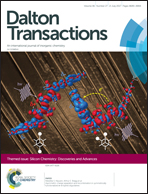[PhSiO1.5]8,10,12 as nanoreactors for non-enzymatic introduction of ortho, meta or para-hydroxyl groups to aromatic molecules†
Abstract
Traditional electrophilic bromination follows long established “rules”: electron-withdrawing substituents cause bromination selective for meta positions, whereas electron-donating substituents favor ortho and para bromination. In contrast, in the [PhSiO1.5]8,10,12 silsesquioxanes, the cages act as bulky, electron withdrawing groups equivalent to CF3; yet bromination under mild conditions, without a catalyst, greatly favors ortho substitution. Surprisingly, ICl iodination without a catalyst favors (>90%) para substitution [p-IC6H4SiO1.5]8,10,12. Finally, nitration and Friedel–Crafts acylation and sulfonylation are highly meta selective, >80%. In principle, the two halogenation formats coupled with the traditional electrophilic reactions provide selective functionalization at each position on the aromatic ring. Furthermore, halogenation serves as a starting point for the synthesis of two structural isomers of practical utility, i.e. in drug prospecting. The o-bromo and p-iodo compounds are easily modified by catalytic cross-coupling to append diverse functional groups. Thereafter, F−/H2O2 treatment cleaves the Si–C bonds replacing Si with OH. This represents a rare opportunity to introduce hydroxyl groups to aromatic rings, a process not easily accomplished using traditional organic synthesis methods. The as-produced phenol provides additional opportunities for modification. Each cage can be considered a nanoreactor generating 8–12 product molecules. Examples given include syntheses of 4,2′-R,OH-stilbenes and 4,4′-R,OH-stilbenes (R = Me, CN). Unoptimized cleavage of the Br/I derivatives yields 55–85% phenol. Unoptimized cleavage of the stilbene derivatives yields 35–40% (3–5 equivalents of phenol) in the preliminary studies presented here. In contrast, meta R-phenol yields are 80% (7–10 mol per cage).
![Graphical abstract: [PhSiO1.5]8,10,12 as nanoreactors for non-enzymatic introduction of ortho, meta or para-hydroxyl groups to aromatic molecules](/en/Image/Get?imageInfo.ImageType=GA&imageInfo.ImageIdentifier.ManuscriptID=C7DT00373K&imageInfo.ImageIdentifier.Year=2017)
- This article is part of the themed collection: Silicon Chemistry: Discoveries and Advances


 Please wait while we load your content...
Please wait while we load your content...